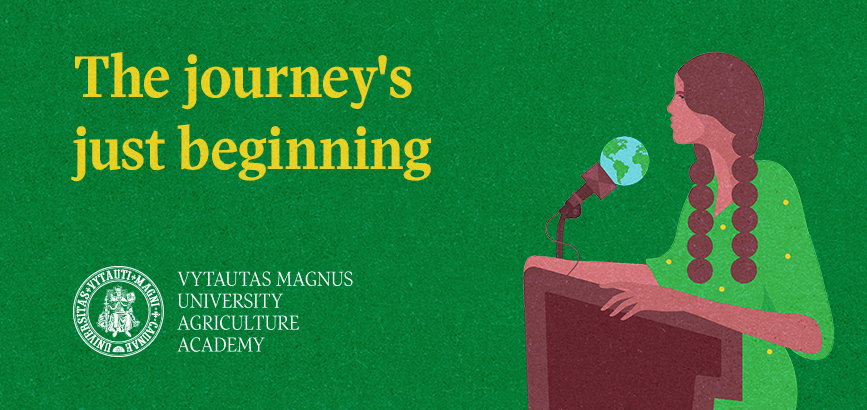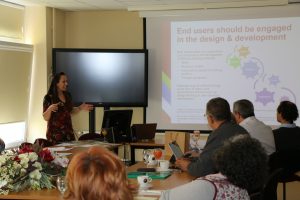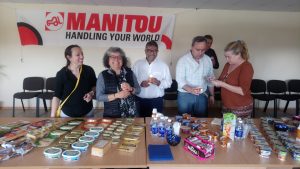COST ACTION SACURIMA meeting
The Agriculture Academy Faculty of Bioeconomy Development at Vytautas Magnus University held a meeting of Working Group 3 under the COST action CA16123 “Safety Culture and Risk Management in Agriculture“ (SACURIMA) and workshop “How to improve safety culture and risk management in vulnerable populations in agriculture?” on 25-26 April 2019.
Researchers and experts from Denmark, Finland, the Netherlands, Portugal, Turkey, Serbia, Estonia, Slovenia, Latvia, the U.S. attended the meeting and shared their experience and knowledge in the field of risk management and safety improvement in agriculture.
H. Birk Domino (SEGES, Denmark) presented the SACURIMA action and main dissemination activities performed until that day and presented the promotion videos made so far by the SACURIMA.
Dr. L. Girdziute and E Besuspariene (Vytautas Magnus University, Lithuania) presented detailed analysis of the pilot survey results on training and integration of vulnerable populations into the agricultural workforce to identify main issues in agricultural workforce and the effective models for training and integration of vulnerable populations into the agricultural workforce.
V. Kargytė (Vytautas Magnus University, Lithuania) presented the results of the study with the insights of student entrepreneurship from more than 50 countries. This was also related to graduates’ entrepreneurship in relation to agricultural activities. Health and safety issues are especially important for this vulnerable population which starts farming activities.
Dr. A. Ramos (Nebraska Medical Center, Omaha) made the presentation “Training and integrating vulnerable workers”. A global migration phenomenon was presented as well as seasonal and contracted agricultural workers in Europe. Main factors such as culture, language, fear and other factors, inadequate knowledge of labour rights and other factors were discussed. She also emphasized why H&S training does not usually work on farms, i.e. it sometimes does not meet the farmers’ needs, there is no leadership, or training methodology in not appropriate for the stakeholders (workers). She introduced the good practice examples partnering with a local farm to reduce worker back pain and injury and demonstrated the brochures how H&S information could be presented to workers by the means of picture dictionary for agriculture. Good practices for the promotion of OHS are: vocabularies for foreign speakers in the country they work, animated magazines, innovative training opportunities including radionovela, fotonovela, storytelling and others. Special focus should be on the vulnerable workers which change their lifestyle from urban to countryside and are not familiar with the risks, long working hrs. Effective models for teaching such as use of own data and communication in native language were also identified as very effective.
Representative of the consultation company SDG (Safe work guarantee) E. Garnytė presented Health and Safety legislation in Lithuania and main hazards in Agriculture (electrical, chemical, ergonomic, dusts, biological factors, weather conditions etc). She emphasized the specifics of agricultural activities, compared to other sectors and pointed the importance of H&S teaching in farms, especially for young workers, as their accident incidence rates are much higher than for other experienced workers.
Dr. E. Merisalu (The Institute of Technology, Estonia) presented the trends in the work related to accidents during previous decade in the EU. The results were presented together with the state of the art of agricultural production. The data was related to occupational accidents in the EU countries. She emphasized the importance of vulnerable workers who are usually not included to the statistical data. Therefore, collection of such information could help analyse deeper the situation. This is especially important in agriculture, forestry and fisheries, where incidence trends are increasing.
Dr. Achutan Chandran (Nebraska Medical Center) presented main results and the survey on the habits of use of personal protective equipment for the participants. The questionnaires were distributed in 4 countries and feedback received from the U.S., Slovenia, Latvia and Lithuania.
Dr. J. Leppala (Natural Resources Institute Finland, Finland) presented the worker management and orientation studies in Finland. Farmers’ perceptions of the required management skills were introduced, and farm safety and security management instruments as well as farm worker management and welfare at work in agriculture were presented. Key aspect of the presentation was to describe the definition “vulnerable population”.
Dr. G. Vasiliauskas (Vytautas Magnus University, Lithuania) presented the Lithuanian data related to prevalence of occupational diseases and accidents in agriculture. Statistical data were presented to show that incidence rate of fatal incidents is almost 6 times higher in agriculture than in other sectors of economic activity.
More discussions about vulnerably populations in agriculture and their safety issues were conducted at the Public Institution Practical Training and Trial Centre of Lithuanian University of Health Sciences (Center). SACURIMA members visited Center’s farm where milk production process safety regulations to ensure workers’ welfare were presented. During the farm visit, company’s “Pieno žvaigždės“ product range and their global supply routes were presented.
The main goal of this COST Action is to reduce the burden of work-related deaths, injuries and illnesses in agriculture.
This COST Action will produce benchmarked and evidence-based recommendations to inform and guide national initiatives and efforts. The results will be made available to the scientific community, policy makers, vocational training, administrative and insurance personnel, farmers and practitioners working towards better social sustainability and safety culture in agriculture.




















